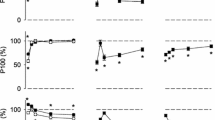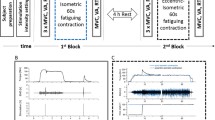Abstract
The contractile properties of the quadriceps muscle were measured in seven healthy male subjects before, during and after prolonged cycling to exhaustion. Special efforts were made to obtain measurements immediately after exercise. The exercise intensity corresponded to about 75% of estimated maximal O2 uptake and time to exhaustion was mean 85 (SEM 9) min. At the end of the cycling heart rate and perceived exertion for the legs were 94% and 97% of maximal values, respectively. Maximal voluntary isometric force (MVC) had decreased after 5 min of exercise to a mean 91 (SEM 4)% of the pre-exercise value (P < 0.05) and decreased further to a mean 82 (SEM 6) and mean 66 (SEM 5)% after 40-min cycling and at exhaustion, respectively. A new finding was that during recovery reversal of MVC occurred in different phases where the half recovery time of the initial rapid phase was about 2 min. The MVC was a mean 80 (SEM 2)% of the pre-exercise value after 30 min and was not affected by superimposed electrical stimulation. Maximal voluntary concentric and eccentric forces decreased to 74% and 80% o of initial values at exhaustion (P < 0.05). The kinetics of isometric contraction expressed as the time between 5% and 50% of tension (rise time) and the time between 95% and 50% of tension (relaxation time) were not significantly affected by the prolonged cycling. The electromechanical delay measured as the time between the first electrical stimulus and 5% of tension decreased from a mean 32 (SEM 1) ms at rest to a mean 26.6 (SEM 0.6) ms at fatigue (P < 0.05). It is concluded that prolonged exhausting cycling results in reduced force-generating capacity during isometric, concentric and eccentric conditions. The absence of a slowing of relaxation and the incomplete reversal of MVC after 30 min of recovery indicate that the mechanism(s) of fatigue during prolonged exercise involve other components than those involved during high intensity exercise.
Similar content being viewed by others
References
Astrand P.-O, Rodahl K (1986) Textbook of work physiology. McGraw-Hill, New York, p 544
Baker AJ, Kostov KG, Miller RG, Weiner MW (1993) Slow force recovery after long duration exercise: metabolic and activation factors in muscle fatigue. J Appl Physiol 74:2294–2300
Bigland-Ritchie B, Woods JJ (1984) Changes in muscle contractile properties and neural control during human muscular fatigue. Muscle Nerve 7:691–699
Borg G (1970) Perceived exertion as an indicator of somatic stress. Scand J Rehabil Med 2:92–98
Broberg S, Sahlin K (1989) Adenine nucleotide degradation in human skeletal muscle during prolonged exercise. J Appl Physiol 67:116–122
Cady EB, Elshore H, Jones DA, Moll A (1989) The metabolic causes of slow relaxation in fatigued human skeletal muscle. J Physiol 418:327–337
Coyle EF, Coggan AR, Hemmert MK, Ivy JL (1986) Muscle glycogen utilization during prolonged strenous exercise when fed carbohydrate. J Appl Physiol 61:165–172
Davies CTM, White MJ (1982) Muscle weakness following dynamic exercise in humans. J Appl Physiol 53:236–241
Davies CTM, Thompson MW (1986) Physiological responses to prolonged exercise in ultramarathon athletes. J Appl Physiol 61:611–617
Edwards RHT (1983) Biochemical bases of fatigue in exercise performance: catastrophe theory of muscular fatigue. In: Vogel HG, Knuttgen HG, Poortmans J (eds) Biochemistry of exercise. International Series on Sports Sciences. Human Kinetics, Champaign, Ill., pp 3–28
Edwards RHT, Young A, Hosking GP, Jones DA (1977) Human skeletal muscle function: description of tests and normal values. Clin Sci Mol Med 52:283–290
Forsberg A, Tesch P, Karlsson J (1979) Effect of prolonged exercise on muscle strength performance. In: Asmussen E, Jorgensen K (eds) Biomechanics VI-A. University Park Press, Baltimore, Md., pp 62–67
Gollnick PD, Körge P, Karpakka J, Saltin B (1991) Elongation of skeletal muscle relaxation during exercise is linked to reduced calcium uptake by the sarcoplastic reticulum in man. Acta Physiol Scand 142:135–136
Green HJ (1991) How important is endogenous muscle glycogen to fatigue in prolonged exercise? Can J Physiol Pharmacol 69:290–297
Hermansen L, Hultman E, Saltin B (1967) Muscle glycogen during prolonged severe exercise. Acta Physiol Scand 71:129–139
Hultman E, Sprier L (1986) Skeletal muscle metabolism, contraction force and glycogen utilization during prolonged electrical stimulation in humans. J Physiol 374:493–501
Lowry OH, Passoneau JV (1972) A flexible system of enzymatic analyses. Academic Press, New York, pp 1–291
Marsden CD, Meadows JC (1970) The effects of adrenaline on the contraction of human muscle. J Physiol 207:429–448
Norman B, Sollevi A, Jansson E (1988) Increased IMP content in glycogen-depleted muscle fibres during submaximal exercise in man. Acta Physiol Scand 133:97–100
Ranatunga KW (1982) Temperature-dependence of shortening velocity and rate of isometric tension development in rat skeletal muscle. J Physiol 329:465–483
Sahlin K, Ren J (1989) Relationship of contraction capacity to metabolic changes during recovery from a fatiguing contraction. J Appl Physiol 67:648–654
Sahlin K, Edström L, Sjöholm H, Hultman E (1981) Effects of lactic acid accumulation and ATP decrease on muscle tension and relaxation. Am J Physiol 240: C121-C126
Sahlin K, Katz A, Broberg SJ (1990) Tricarboxylic acid cycle intermediates in human muscle during prolonged exercise. Am J Physiol 259: C834-C841
Sargeant AJ, Dolan P, (1987a) Human muscle function following prolonged eccentric exercise. Eur J Appl Physiol 56: 704–711
Sargeant AJ, Dolan P (1987b). Effect of prior exercise on maximal short-term power output in humans. J Appl Physiol 63:1475–1480
Seger JY, Westing SH, Hanson M, Karlson E, Ekbolm B (1988) A new dynamometer measuring concentric and eccentric muscle strength during accelerated, decelerated, or isokinetic movements. Eur J Appl Physiol 57:526–530
Sherman WM, Armstrong LE, Murray TM, Hagerman FC, Costill DL, Staron RC, Ivy JL (1984) Effect of 42.2-km footrace and subsequent rest or exercise on muscular strength and work capacity. J Appl Physiol 57:1668–1673
Sjöholm H, Sahlin K, Edström L, Hultman E (1983) Quantitative estimation of anaerobic and oxidative energy metabolism and contraction characteristics in intact human skeletal muscle in response to electrical stimulation. Clin Sci 3: 227–239
Spencer MK, Yan Z, Katz A (1991) Carbohydrate supplementation attenuates IMP accumulation in human muscle during prolonged exercise. Am J Physiol 261: C71-C76
Viitasalo JT, Komi PV (1981) Effects of fatigue on isometric forceand relaxation-time characteristics in human muscle. Acta Physiol Scand 111:87–95
Viitasalo JT, Komi PV, Jacobs I, Karlsson J (1982) Effects of prolonged cross-country skiing on neuromuscular performance. In: Komi PV (ed) Exercise and sport biology. International Series on Sport Sciences, Vol 12. Human Kinetics Champaign, Ill., pp 191–198
Völlestad NK, Sejersted OM, Bahr R, Woods JJ, Bigland-Ritchie B (1988) Motor drive and metabolic responses during repeated submaximal contractions in humans. J Appl Physiol 64: 1421–1427
Westerblad H, Lännergren J (1991) Slowing of relaxation during fatigue in single mouse muscle fibres. J Physiol 434:323–336
Wiles CM, Edwards RHT (1982) The effect of temperature, ischaemia and contractile activity on the relaxation rate of human muscle. Clin Physiol 2:485–497
Wiles CM, Young A, Jones DA, Edwards RHT (1979) Relaxation rate of constituent muscle-fibre types in human quadriceps. Clin Sci 56:47–52
Author information
Authors and Affiliations
Rights and permissions
About this article
Cite this article
Sahlin, K., Seger, J.Y. Effects of prolonged exercise on the contractile properties of human quadriceps muscle. Europ. J. Appl. Physiol. 71, 180–186 (1995). https://doi.org/10.1007/BF00854977
Accepted:
Issue Date:
DOI: https://doi.org/10.1007/BF00854977




